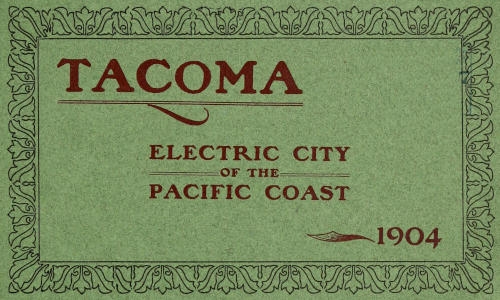
TACOMA
ELECTRIC CITY
OF THE
PACIFIC COAST
1904

1904
| WILLIAM JONES, President. | A. F. ALBERTSON, Vice President. | HENRY A. RHODES, Treasurer. |
J. S. WHITEHOUSE, Secretary.
|
|
|
This pamphlet is issued by the Tacoma Chamber of Commerce and Board of Trade. Its object is to present reliable information concerning Tacoma and to interest in this city those who desire a location on the Pacific Slope in which to engage in business, manufacturing or shipping, or a desirable place in which to live.
The information herein contained is reliable and the statistics are official and up-to-date.
Further or special information of any character will be cheerfully furnished upon application to the
SECRETARY CHAMBER OF COMMERCE
Tacoma, Wash.
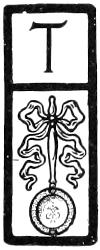
Tacoma, the Electric City of the Pacific Coast, and the chief seaport of the North Pacific, is situated at the head of ocean navigation on Puget Sound in latitude 47° 15´ north and longitude 122° 25´ west from Greenwich. Being further north than Duluth or Quebec, Tacoma is supposed by many to be bleak and cold. A popular misapprehension among Eastern people seems to be that Puget Sound is somewhere near Alaska and that for half of the year the people contend with snow and ice.
The climate of the Pacific Slope west of the Cascade Mountains is tempered by the Pacific Ocean, the “Japan current” and the equable southwesterly winds. The climate resembles that of Western Europe rather than that of the American Continent east of the Rocky Mountains. Tacoma is four degrees further south than London, in about the same latitude as Nantes, the chief city of Brittany, near the mouth of the Loire. The climate of Puget Sound is warmer in winter and cooler in summer than that of Southern England, and is the most equable, salubrious and delightful to be found in the United States.
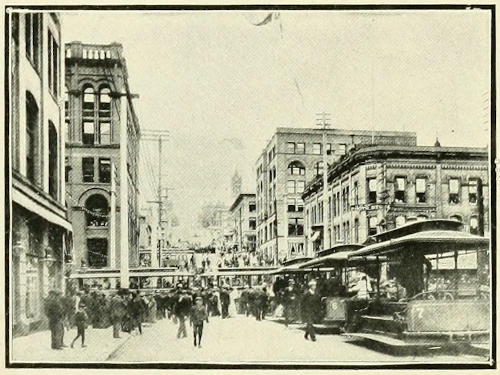
Eleventh Street at Pacific Avenue.
Tacoma’s winters are open, the grass is green and flowers bloom out of doors every month in the year. Last winter the temperature fell below the freezing point (32° above zero, Fahrenheit), on one day in November, six days in December, three days in January, five days in February and eight days in March. The minimum temperature on the coldest day in November was 28° above zero; in December, 29°; in January, 26°; in February, 23°; and in March, 29°. It would be more accurate to speak of the “winter” months as the “rainy season,” for one-half of the annual precipitation, which amounted to 45.11 inches in 1903, an amount slightly above the average rainfall, fell during the three months of January, November and December. Tacoma has little snow and no ice. Cyclones or furious winds, in this peculiarly sheltered region between the Olympics and the Cascades, are unknown.
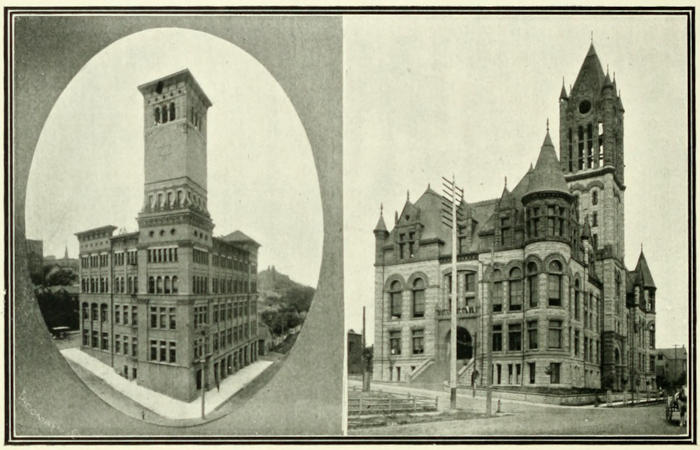
City Hall. Pierce County Court House.
Tacoma’s summer climate is equally free from extremes. The temperature rarely rises to 80° Fahrenheit on summer afternoons. In the summer of 1903, for example, the mercury rose to 80° on only three days in June, two days in July, once in August and once in September. The nights are always cool, the days bright and balmy. Thunder and lightning are exceedingly rare occurrences. Nowhere in the world is the climate more conducive to health, longevity, exhilaration of mind and body, and to the production of flowers, fruits, forests and crops in greater abundance and variety.
Tacoma is one of the healthiest cities in the world. The number of deaths during the last census year was 425, indicating an annual death rate of 11.3 per 1,000, which is fully one-third less than the average annual death rate for the United States, 17.4 per 1,000, and almost the lowest reported from any one of the registration cities of the country. Since 1900 the death rate at Tacoma has decreased. The total number of deaths for twelve months ending June 30, 1904, was 520. The population of the city has increased 60 per cent. since the last federal census was taken and the annual death rate does not now exceed 8.67 per 1,000. Tacoma may fairly claim to be the healthiest city in the world.
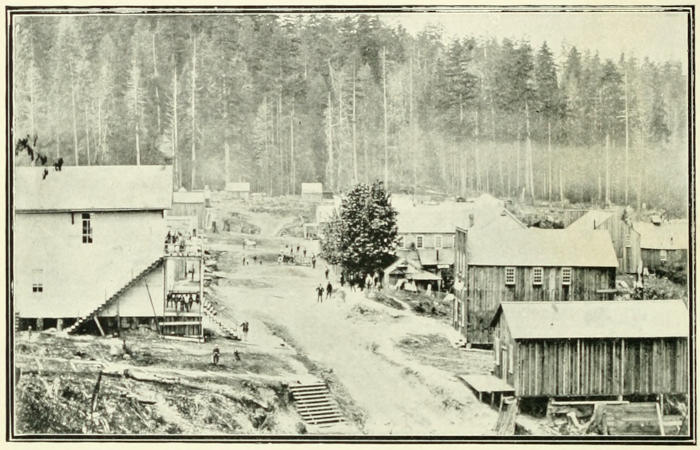
Tacoma in 1871.
Tacoma is the youngest of the maritime cities of the United States. It is situated on one of the finest harbors in the world. It is the leading seaport of Puget Sound, the gateway to the Orient and Alaska. It is second only to San Francisco on the Pacific Coast in the volume and value of its foreign commerce. It is the chief Pacific Coast port for steamship lines maintaining regular sailings between Tacoma and Japan, Asiatic Russia, China and Manila; between Tacoma and London, Liverpool and Glasgow by way of the Orient, Suez Canal and the Mediterranean, the longest regular steamship route in the world; and between Tacoma and Hamburg, the chief seaport of Continental Europe, by way of Mexican, Central and South American ports. Tacoma is in direct, regular steamship communication with Alaska, San Francisco, Honolulu and New York. Tacoma is the western headquarters and chief Pacific Coast terminal of the Northern Pacific railway and the headquarters and western terminal of the Tacoma Eastern railroad, the most important independent railway in the State and the tourist route to Paradise Valley and Mount Tacoma. Tacoma handles the largest railway freight traffic of any city in the Pacific Northwest. It is the center and operating point of a system of city, suburban, and interurban electric railways, with 135 miles of track. It is the chief emporium, manufacturing and distributing point for the leading staple products of the forests, farms, mines and waters of the State of Washington and Alaska, and the “Inland Empire,” the valleys of the Upper Columbia and Snake Rivers in Eastern Washington and Idaho, between the Cascade Range and the Rocky Mountains. It is the chief wheat exporting and flour milling city of the Pacific Coast. It is the first city of the Pacific Northwest in manufactures. It is the electric city of the Pacific Coast with natural power resources unequalled at any city in America except Niagara Falls. It is the “home City” of the North Pacific Coast, and possesses scenic attractions which evoked from Sir Henry Irving the declaration that Tacoma has the most beautiful situation and environment of all the cities he had visited in the world. It is an educational, literary, musical and social center, with several institutions of higher learning, a Public Library, a famous Museum, 800 acres of parks of surpassing beauty, broad streets, fine public and private buildings, theaters, hotels, churches, hospitals, charitable and benevolent institutions and a rapidly growing population of enterprising, prosperous and hospitable people.
Tacoma dates its birth from July 14, 1873. On that day the commissioners appointed to locate the Puget Sound terminal of the Northern Pacific railway decided to recommend as such a point on the south side of Commencement Bay, in township twenty-one, range three east of the Willamette meridian. Commencement Bay was the largest and best sheltered harbor to be found on Puget Sound and was accessible by easy grades for railways from the north, south and east, and by several easy passes over the great Cascade Mountain range. Into the bay flows the Puyallup River, fed by the eternal glaciers of Mount Tacoma, the giant dome of snow whose image Theodore Winthrop found “displaced in the blue depths of tranquil waters” in the bay. The shore line of the bay, stretching ten miles from Brown’s Point at the northeast to Point Defiance at the northwest was at the time referred to unbroken by human habitations, save a hamlet clustering about a saw mill on the west shore of the bay, a view of which, from a photograph taken in 1871, is presented on the opposite page. In 1870 the federal census enumerator had found seventy-three inhabitants at Tacoma.
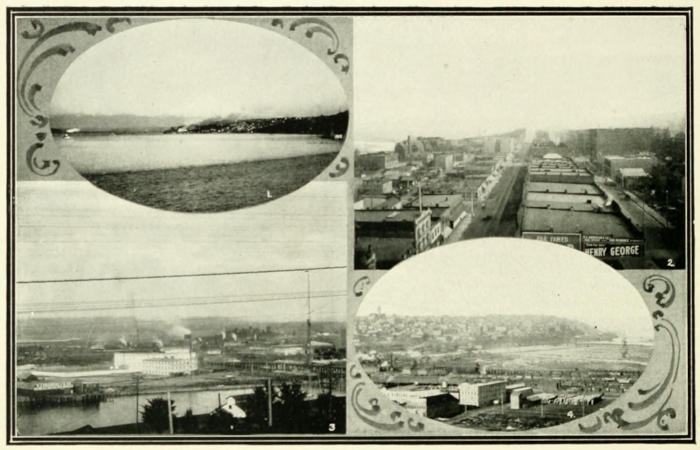
Tacoma in 1904.
In the Ferry Museum is the original plat or sub-division of some lands near the saw mill. It is entitled a map of lots at “Commencement City,” but a line is drawn through this name and the word “Tacoma” substituted. The owners of the land discussed the name “Commencement City” in the officers’ room of a Portland bank and rejected it as an awkward designation. They preferred instead the euphoneous Indian name of the mountain which rises majestically to a height of 14,526 feet southeast of the bay and commands the site of the city that was to be erected apparently at its very base. When President Roosevelt was Assistant Secretary of the Navy, he selected Tacoma as the name of a new cruiser, remarking that in his judgment the name should have been adopted as the name of the State, instead of Washington.
The selection of Tacoma in 1873 as the terminus of the Northern Pacific railway sealed its destiny as a great city. During the same year a section of the road was completed and opened extending from the north bank of the Columbia River at Kalama to Tacoma. The largest towns at that time in the Pacific Northwest were Portland and Victoria. The route between the two was by river steamer from Portland to Kalama, thence by rail to Tacoma, and thence by sound steamer to Victoria and intermediate points, Seattle being the largest town on the route. Fourteen years, however, elapsed before the main transcontinental line of the Northern Pacific crossed the Cascades and entered Tacoma from the east.
Tacoma’s population, according to the federal census, the annual school census, the directory lists, and other accepted bases of calculation, has increased as follows:
| City Limits. | City and Suburbs. |
|
|---|---|---|
| 1870 | 73 | |
| 1880 | 1,098 | |
| 1900 | 37,714 | 42,311 |
| 1904 | 60,250 | 67,405 |
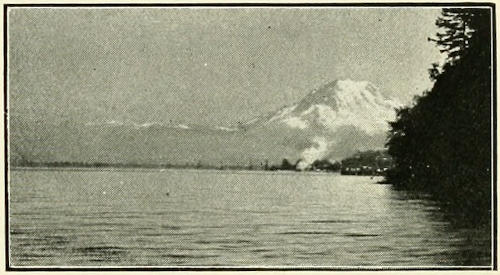
Mount Tacoma from Point Defiance.
The figures for 1870, 1880 and 1900 above quoted are from the federal census. The number of names of individuals, exclusive of all names of firms, corporations, buildings and the like, in the city directory for 1900, published by R. L. Polk & Co., was 16,951. The district canvassed for the city directory includes the immediate suburbs, which are to all intents and purposes a part of the community. The ratio between the number of names in the directory of 1900 and the population of the city and immediate suburbs, as shown by the last federal census, was 1 to 2½. The number of names of individuals in the Tacoma city directory in 1900 and subsequent years with the population as indicated by the use of the multiplier 2½ is as follows:
| Year. | Names in City Directory. |
Estimated Population. |
|---|---|---|
| 1900 | 16,951 | *42,372 |
| 1901 | 20,418 | 51,045 |
| 1902 | 22,186 | 55,455 |
| 1903 | 25,057 | 62,642 |
| 1904 | 26,962 | 67,405 |
* Federal enumeration, 42,311.
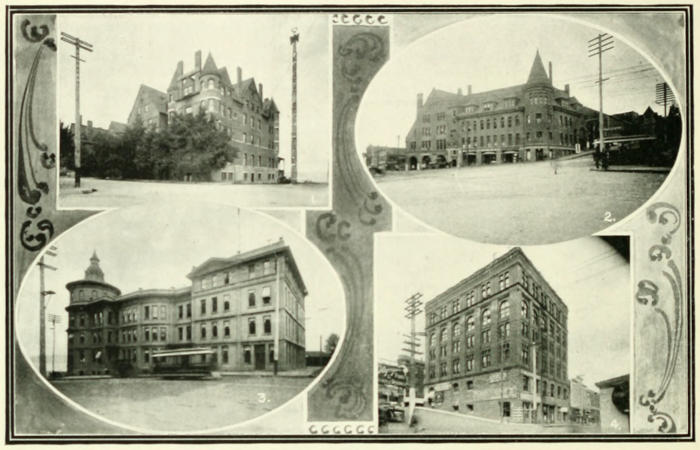
This estimate of population in 1904 is confirmed by the annual school census returns. The school census of 1904 for school district number 10, which is coextensive with the city limits, reports 13,389 children of school age residing in the district, as compared with 9,443 in 1900. The census of the districts contiguous to the city and embracing its immediate suburbs show a school population in 1904 of 1,426, as compared with 646 in 1900. The use of the multiplier 4½ applied to the school census returns, indicates a population within the city limits in 1904 of 60,250 and in the city and its immediate suburbs of 66,667. Other cities in the state employ a larger multiplier than 4½ to estimate population from their school census returns. For example, Seattle applies the multiplier 6½, and Spokane 5¾ to their school census returns in order to confirm their liberal estimates of population. Tacoma is content to employ a safe and conservative method of calculation.
Postoffice receipts more than confirm the foregoing estimates as to Tacoma’s growth and present population. The receipts of the Tacoma postoffice for the fiscal year ending June 30, 1904, were $113,599, as compared with $63,928 for the year ending June 30, 1900. The increase in postoffice receipts is at the rate of 14.7 per cent. in one year; 28.2 per cent. in two years; 53.7 per cent. in three years and 77.4 per cent. in four years. The increase in population as above shown by an increase of 10,011 in the number of names in the city directory is at the considerably lower rate of 59.0 per cent. in four years.
Tacoma’s rapid growth is attributable to two principal causes. First, the industrial, and second, the commercial development of the city. There are abundant grounds for the prediction that Tacoma will not only continue to hold her position as the leading manufacturing city in the State of Washington, but will rapidly become one of the greatest industrial centers in the world. Tacoma possesses unequalled facilities for manufacturing in several important fields of industry. The first superior advantage is abundance of cheap power; the second is the possession or command of the raw materials, and the third is direct transportation facilities placing her in touch with the markets of the world.
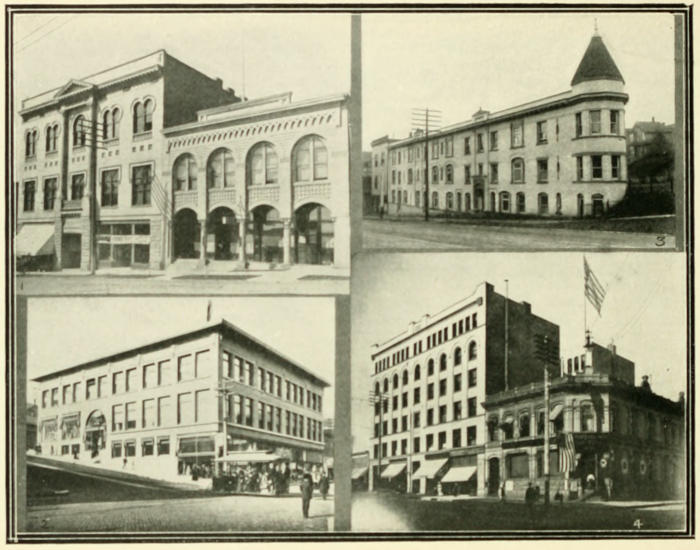
Some New Buildings.
Mr. E. W. Parker, of the United States Geological Survey, who served by appointment of President Roosevelt as one of the anthracite strike arbitrators, recently called the attention of the Washington State Press Association to the fact that Pennsylvania, Illinois, Colorado and Washington are the chief coal-producing States in the four longitudinal sections or belts of the United States from east to west and that each of these States takes the lead in manufacturing among all the States in its section. Washington has incalculable supplies of coal of excellent quality for producing heat and generating steam. The coal is stored in the Cascade Mountains and the mines of Pierce, Kittitas and Southern King Counties are in close and direct railway communication with Tacoma. It is said that the cars loaded with coal at fifty mine openings in Western Washington, would run by gravity into Tacoma by simply unloosening the brakes. Tacoma has huge bunkers for coaling steamships and a line of colliers plies constantly between this port and San Francisco. The best, if not the only coking coal yet mined in Washington is found in abundance in Pierce County within thirty miles of Tacoma. But fuel from the waste of the great lumber mills is so abundant and cheap in Tacoma that the tremendous advantage of her proximity to the rich coal fields of Washington is not as yet fully realized.
Of even greater value than her coal as a factor in the industrial development of Tacoma is the utilization of the enormous water power which has its origin and source in the snow-capped and glacier-buttressed dome of Mount Tacoma. The mountain from which Tacoma takes her name is an inexhaustible reservoir of power whose efficiency is immeasurable. Tacoma lies at its feet and is the natural outlet and market for its harnessed energies.
Science has discovered the means for the conversion of water power into electrical energy transmissible over a wire from the place of its generation to a convenient point for its application and use. There is a loss in transmission which increases with the distance. Therefore Tacoma, which is the nearest seaport and railway terminal to the mountain from whose dizzy heights torrents of water rush ceaselessly to the sea level, is favored by her geographical position in the use of this power. There are numerous streams which make a descent of thousands of feet within fifty miles of the city. Capital has been enlisted and freely expended in the work of generating power for industrial and transportation purposes, besides current for light and heat.
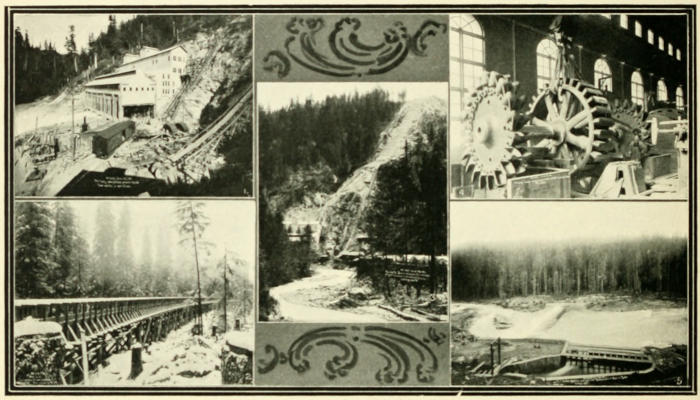
Puget Sound Power Company’s Plant.
The largest plant in the world for the generation of electric current by water power, with the single exception of the power plant at Niagara Falls, has been installed during the last eighteen months by the Puget Sound Power Company, of Tacoma, at Electron, twenty-eight miles southeast of Tacoma, near Lake Kapowsin, on the Tacoma Eastern railroad. The work of installing the power plant at Electron was commenced early in 1903. The first unit of 5,000-horse power was ready for trial on April 14, 1904, and before the end of July, 1904, four 5,000-horse power units, making a total of 20,000-horse power, were completely installed and in commercial operation. The Puget Sound Power Company is owned by Messrs. Stone & Webster, of Boston, who control and operate the Tacoma Railway & Power Company, the Tacoma and Seattle Interurban railway and the Seattle Electric Railway Company. The plant at Electron was installed in order to furnish power for operation of the urban, suburban and interurban railways of the Puget Sound cities and to market the surplus to other power consumers.
A page of illustrations is here presented showing, from recent photographs, some of the principal features of the power plant at Electron. The water for the plant is taken from the south fork of the Puyallup River, below its junction with the Mowich, thirty-five miles from Tacoma and 1,800 feet above sea level. The river at this point drains five of the largest glaciers of Mount Tacoma. A low dam has been constructed, shown in the photograph of the headworks, whence the water is conducted by a flume eight feet wide and eight feet deep, following the contour of the river canyon and descending at the rate of seven feet to the mile, ten miles and a half to a reservoir covering twenty-one acres and averaging twenty feet in depth, on the crest of the hill above the power house. The reservoir holds in reserve ten hours’ supply for the power plant. The water is dropped from the reservoir to the power house through four steel pipes or penstock lines, 1,700 feet in length, erected on the slope of the canyon at an angle of about 45 degrees. A fall of 887 feet and a pressure of 400 pounds to the square inch is thus secured. Four million pounds of steel pipe were required for the penstock line, each cylinder being four feet in diameter at the top and reducing to two seven-inch nozzles for each pipe. The water issues from the nozzles at a speed of about three miles a minute and is applied to four impulse water-wheels specially constructed for the purpose. The present electrical installation includes four generators, each of 3,500 kilowatts capacity. The flume, the reservoir, the forebay, the slope for the penstock line and the site for the power house have been constructed or prepared with a view of adding to the capacity of the plant. The west wall of the power house shown in the illustration is temporary, in contemplation of its extension and the installation of from two to four additional 5,000-horse power units as soon as required.
The present plant is abundantly supplied with water by the flume filled to a depth of three feet. The water passes through the flume at the rate of seven miles an hour. There is abundance of water for the operation of the plant in the Puyallup River at all seasons of the year, as the river is fed by torrents from the glaciers in the dry season and by copious rains in the winter.
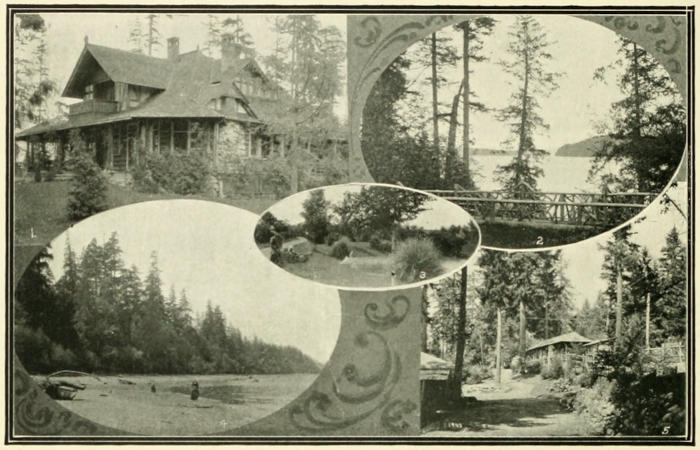
Views in Tacoma’s Parks.
The Puget Sound Power Company, of Tacoma, has a large surplus of power above the requirements of the electric railways controlled by Stone & Webster. This power is already used to pump water from the new driven wells at South Tacoma for the city of Tacoma, also to operate the great railway construction and repair plant of the Northern Pacific railway at South Tacoma, the new packing house plant of the Carstens Packing Company on the tideflats, the large grain warehouses and elevators between the Eleventh Street bridge and the Government warehouse on the city waterway, numerous furniture factories, machine shops, pipe and iron foundries, and a large number of stationary motors for miscellaneous enterprises at Tacoma, besides supplying current for light and power in the valley towns between Tacoma and Seattle and the latter city. The transmission line from Electron to Tacoma is twenty-eight miles in length, while the distance from the plant to Seattle is forty-eight miles.
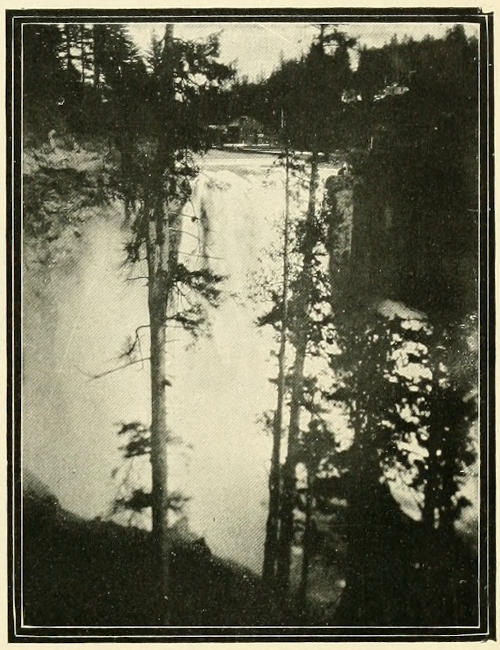
Snoqualmie Falls, 270 Feet High.
The colossal power plant at Electron is not the only enterprise of its kind that is contributing to the industrial growth of Tacoma. The Cascade Mountains are the source of many rivers which have filed out deep canyons and here and there plunge over lofty precipices seeking ocean level in Puget Sound not many miles away. The first of the waterfalls in the foothills of the Cascades to be harnessed to generate electric power for transmission to the Puget Sound cities was Snoqualmie Falls, 270 feet in height, or nearly twice as high as the falls of the Niagara River. A plant generating 10,000-horse power was installed at Snoqualmie Falls about four years ago, a large share of the product of which is transmitted to Tacoma, forty-four miles distant, where it is employed for city lighting and important industrial purposes, such as supplying power to the Tacoma Smelter, Tacoma Grain Company’s flour mills, and many other manufacturing enterprises.
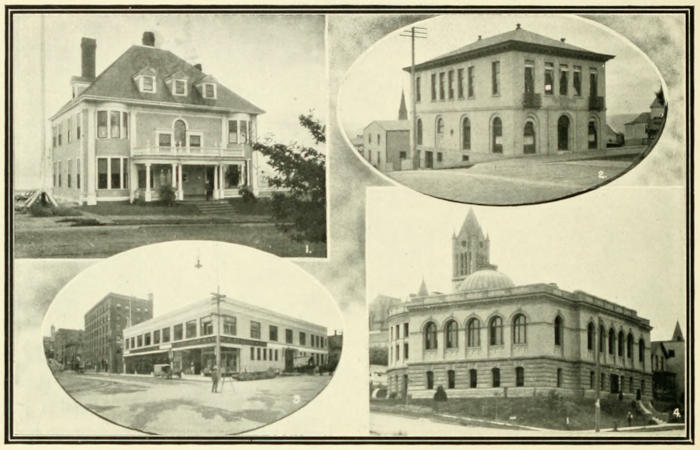
A fire destroyed the transformer house at the Snoqualmie Falls power plant September 20, 1903. A new fire-proof transformer house has been erected in which four transformers of 2,500 kilowatts, or about 3,300-horse power each, have been installed in place of a battery of thirteen 550 kilowatt transformers, thus increasing the capacity of the transformers by more than 4,000-horse power.
The product of the Snoqualmie power plant was in use up to its limit when the fire of September, 1903, occurred, and the Tacoma Cataract Company, distributors of the Snoqualmie power in this city, had already begun the construction of an auxiliary steam power plant on the tideflats at Tacoma, which was completed and placed in operation December 20, 1903. It adds 1,500-horse power to the product of the Snoqualmie Falls power plant employed at Tacoma.
The inadequacy of the Snoqualmie Falls power plant to meet the demand for power for municipal and industrial purposes at Tacoma, prompted its owners to undertake a much larger enterprise, which will result in the construction of still another mammoth power plant within ten miles of the city of Tacoma.
The plan which is being carried out by what is known as the White River Power Company, is to divert the White River about half a mile above the town of Buckley into a canal, beginning at this point and extending a distance of about five miles across the tableland to Lake Tapps. The canal is being excavated like an ordinary railway cut out of the solid gravel, hardpan or earth or whatever the geological formation happens to be. It will be thirty feet in width on the bottom and fifty-five feet wide at the top and eight feet deep. Dams are to be constructed at the low points on the northerly side of Lake Tapps so that the lake can be raised to a level thirty-five feet higher than the present, which will cause the lake to overflow and merge with Kirtley Lake, Crawford Lake and Kelly Lake, covering all the intervening bottom lands and valleys so that the total area thus submerged and overflowed will exceed 4,000 acres of land. This lake may be drawn down thirty feet. This reservoir will be supplied by the flood waters of White River and will be drawn out through the water wheels during the season of low water, and by thus equalizing the flow of the river will make the power plant capable of a continuous development of 100,000-horse power. The reservoir will permit the plant to run at full load for several months, even if White River were to run dry or the use of the supply canal were to be discontinued for that length of time.
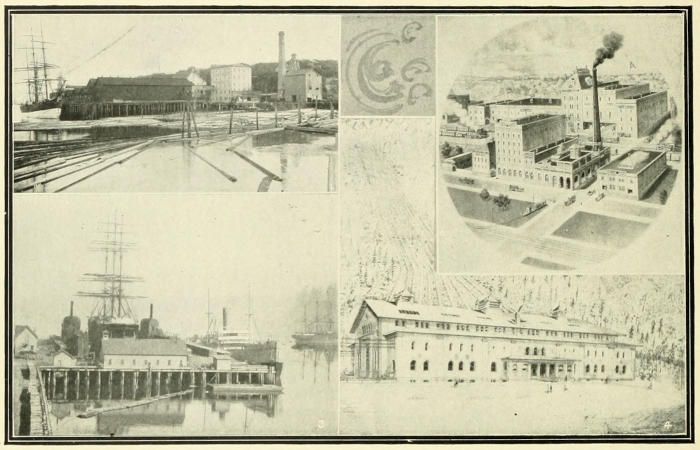
The water from this enlarged lake reservoir will be led through a channel into a masonry penstock whence pressure pipes will conduct it down a declivity to the site of the power house, within ten miles of Tacoma, giving a fall of 485 feet. At the foot of these pipes the power house, 105×250 feet, will be constructed, as shown on the opposite page, and the water will thence be released into the Stuck River. A short transmission line will conduct the power to the Tacoma Cataract Company building in this city, whence a large share of the present output of the Snoqualmie Falls power plant is now distributed to consumers, public and private, in Tacoma.
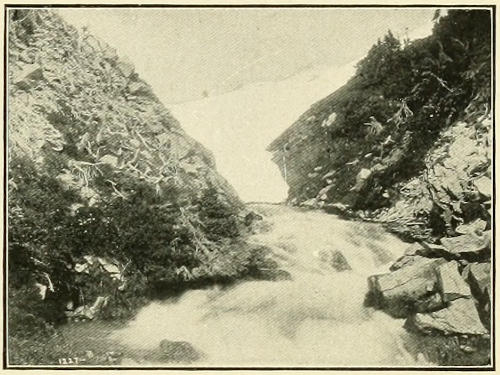
Nisqually River at Its Source in a Glacier.
There are many other rivers or streams fed by the glaciers and snows of Mount Tacoma which may and will be utilized for generating electrical power as rapidly as required. The Tacoma Industrial Company has recently bought a continuous strip four miles in length, including the White River, and is making preparations to install a 15,000-horse power plant twelve miles from Tacoma. The Nisqually River, which flows into the Sound south of Tacoma, has enormous undeveloped power resources. Within thirty miles of Tacoma, at Le Grand, a station on the Tacoma Eastern, on the brink of the Nisqually Canyon, is an available and accessible water power capable of generating 30,000-horse power. Tacoma commands the use of from 150,000 to 200,000-horse power as soon as required.
NO OTHER SEAPORT IN THE WORLD HAS SUCH ABUNDANT RESOURCES OF CHEAP POWER FOR MANUFACTURING PURPOSES.
POWER IS BEING DELIVERED TO THE CITY OF TACOMA FOR PUMPING AND LIGHTING PURPOSES AT THE LOWEST CONTRACT PRICES AT WHICH POWER IS OBTAINED AT ANY CITY IN THE WORLD.
MANUFACTURERS AT TACOMA ARE OBTAINING ELECTRIC POWER AT A LOWER PRICE THAN THAT AT WHICH POWER IS OBTAINABLE AT ANY OTHER TIDEWATER PORT IN THE UNITED STATES.
TACOMA IS THE ELECTRIC CITY OF THE PACIFIC COAST.
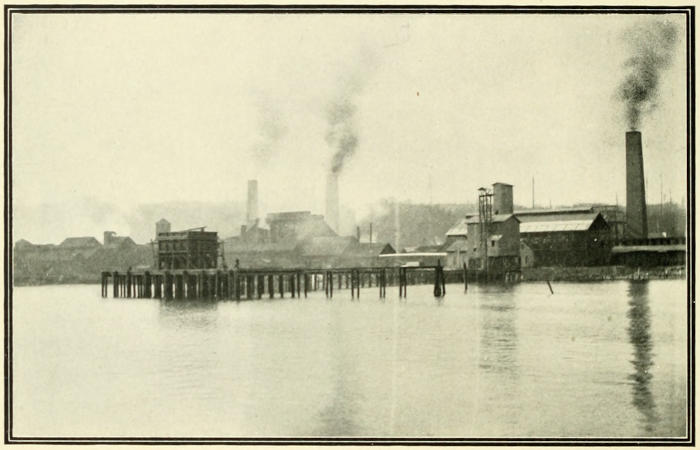
Tacoma Smelter.
Another important factor in Tacoma’s industrial development, past, present and future, is its proximity and convenient access to the natural products or raw materials employed in manufacturing. Tacoma is the point at which the leading staple products of Washington are chiefly assembled for manufacture and distribution. The resources of “Wonderful Washington” are manifold. The products of the mines, the forests, the farms and ranches, and of the waters are of untold value to the world. Tacoma’s geographical position is such that she commands these products as does no other point in the pacific Northwest. The great Olympic Peninsula between Puget Sound and the Pacific Ocean is surrounded by water on three sides. Railroads are required to bring its products to tidewater, and Tacoma, at the head of ocean navigation on the Sound, is in closest proximity of all the Sound ports to this section rich in timber and mineral resources. South, southeast, east and northeast of Tacoma are equally rich sections of territory extending from the Sound on the north and west to the Columbia River on the south and to the ridge line of the Cascade Mountains on the east, whose treasures of agricultural, mineral and forest wealth must seek the markets of the world through this port. Tacoma is the natural and exclusive outlet for the products of this region. Six steam and four electric railway lines radiating from Tacoma, and numerous steamers plying between Tacoma and the island and mainland ports of the Sound afford transportation facilities for the traffic of the immediate and more remote regions tributary to the city. Across and beyond the mountain passes lie the Yakima Valley, the “Inland Empire,” and the greater domain of the United States whose products seeking trans-pacific markets pass through this natural gateway to the Orient.
Puget Sound is 300 miles nearer Japan, Manila and the Orient than San Francisco. It is 800 miles nearer Alaska than the Golden Gate. Ores for the Tacoma Smelter are brought by rail from Eastern Washington and by water from Alaska; from the islands along the coast of British North America; from British Columbia, Korea, Straits Settlements, Mexico and Central America. Foreign products brought across the pacific for manufacture in the United States, such as raw silk from China and Japan and hemp from Manila, are landed at Tacoma. The rail and water transportation facilities which unite at Tacoma, coupled with its command of raw materials and its wonderful resources of power and coal, make this city a most exceptionally favored point for manufacturing.
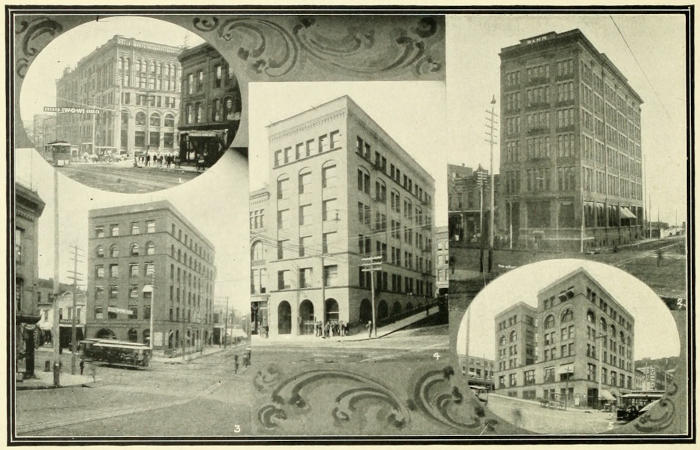
Homes of Tacoma Banks.
A resume of Tacoma’s superior advantages for manufacturing would be incomplete without reference to its abundant supply of manufacturing sites. There are twelve square miles of tide and river flats immediately east of the city which, owing to a combination of circumstances, were until recently incapable of private ownership and occupation. At the south end or head of Commencement Bay there is a level plain traversed near its westerly side by the Puyallup River. The lands on the easterly side of the river were for many years set apart by the government as a part of the Puyallup Indian reservation, but recently these have been sold by order of the government. The King County line extended also to the Puyallup River and the tide and river flats at the head of the bay—most advantageously located for commercial and industrial purposes—being without their jurisdiction, were incapable of improvement by the city or Pierce County. But in 1901 the reservation lands were legally annexed to Pierce County, of which Tacoma is the county seat, and the occupation of this enormous area of flat lands adjacent to tidewater has just begun.
A substantial bridge has this year been erected by the city of Tacoma across the Puyallup River at a convenient point for access to the annexed lands from the manufacturing district which occupies the flats west of the Puyallup River. The federal government has made a complete survey of the harbor of Tacoma, the plans for the improvement of which contemplate the construction of a series of waterways extending from deep water in the bay a considerable distance to the south. The City Waterway, which is being dredged to a width of 550 feet and depths increasing as it approaches the bay from fifteen to thirty feet, under a contract awarded by the federal government in January, 1903, extends as far south as Twenty-third Street, or nearly twenty city blocks from the original harbor line. Miles of additional waterfront and wharves will thus be obtained at the head of the bay, exclusive of the natural shore line some ten miles in extent from Brown’s Point to Point Defiance. Railroads and steamships will have direct and immediate access to the very heart of this district. The acquisition and improvement by the construction of roads, bridges and waterways of 6,000 acres of land immediately adjacent to the city, make it possible for many more manufacturers to secure sites and utilize the limitless power resources of Tacoma, the great Industrial City of the Pacific Northwest.
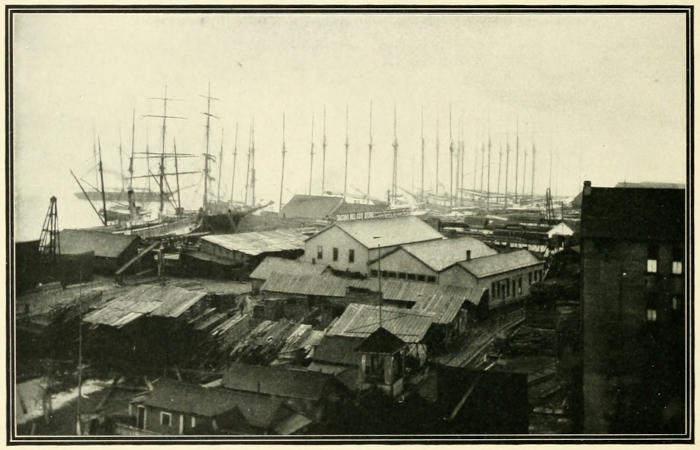
Loading Lumber at Tacoma Mill Company’s Wharf.
Tacoma is now the leading manufacturing city of Washington and the Pacific Northwest. The industrial development of the city since 1900 has been phenomenal. According to the federal census there were in 1900 381 manufacturing establishments at Tacoma, whose aggregate invested capital was $8,146,691, of which there were 385 proprietors and in whose employ there were 293 salaried officials and clerks and 4,347 wage-earners. Of this total number of wage-earners in manufacturing and mechanical industries at Tacoma, 4,104 were men, while only 243 were women or children under the age of 16 years. The total value of the products, including custom work and repairing, of the 381 establishments at Tacoma for the year preceding the taking of the census was $12,029,497.
MORE THAN ONE HUNDRED NEW MILLS AND FACTORIES HAVE BEEN ADDED TO THE LIST OF TACOMA’S MANUFACTURING INDUSTRIES DURING THE FOUR YEARS THAT HAVE ELAPSED SINCE THE FEDERAL CENSUS WAS TAKEN. THAT IS AN AVERAGE OF MORE THAN TWO NEW FACTORIES EVERY MONTH. MANY OF THE OLDER ESTABLISHMENTS HAVE DOUBLED OR TREBLED THEIR CAPACITY DURING THE SAME PERIOD.
No complete summary of the operations of Tacoma’s manufacturing establishments can be presented for comparison with the census report of 1900. But from written reports submitted to the Tacoma Daily News by some of the leading manufacturing concerns in Tacoma, it appears that during the calendar year 1903, one hundred and thirty-five representative manufacturers in the city employed an average of 6,796 wage-earners during the year, while the value of the finished product of these establishments alone for the same year was $28,932,295, and the cost of permanent improvements or additions to the plants during the year was $1,129,550. In other words, 135 out of 500 to 600 establishments that would now be classified by the census as manufacturing concerns in this city employed 2,349 more wage-earners in 1903 than were employed by a total of 389 establishments during the census year, while the value of the output of these 135 establishments in 1903 was nearly two and one-half times as great as the total value of the product of 389 establishments in 1900.
Tacoma is the largest lumber manufacturing point on the Pacific Coast. The manufacture of lumber is the most important industry in the Pacific Northwest. In 1900 there were twelve lumber and shingle mills in operation in Tacoma. In 1903 there were twenty-two in operation, employing an average of 2,682 wage-earners. The increase in the lumber and shingle output since 1900 may be shown by the following figures, based upon reports from the local mills.
Cut of Tacoma Lumber Mills.
| Year. | Lumber, feet. | Shingles. | Total value. |
|---|---|---|---|
| 1900 | 185,414,130 | 178,386,000 | $2,517,967 |
| 1901 | 219,150,000 | 251,000,000 | 2,695,700 |
| 1902 | 303,654,557 | 347,565,000 | 4,069,000 |
| 1903 | 361,522,766 | 376,935,500 | 5,110,398 |
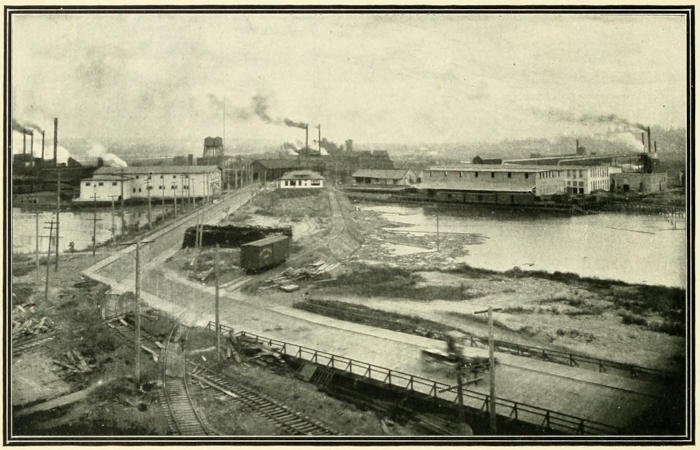
St. Paul & Tacoma Lumber Company’s Mill and Wheeler-Osgood Company’s New Sash and Door Factory.
The increase in three years in the number of mills engaged in the lumber and shingle industry at Tacoma is at the rate of 83.3 per cent.; in the lumber cut at the rate of 96.6 per cent.; in the output of shingles at the rate of 94.0 per cent.; and in the value of the product at the rate of 103.0 per cent.
The St. Paul & Tacoma Lumber Company’s plant on the flats between the City Waterway and the Puyallup River, is the largest saw mill plant in the United States and probably in the world. It was established in 1888. Its original capacity of 300,000 feet per diem has been increased to 500,000 feet by the erection of a second mill since 1900, and during the year 1903 the company cut 122,348,562 feet of fir, spruce, hemlock and cedar and sawed, dried and packed 63,822,000 shingles, its output for the year being valued at $1,761,698. The company operates five logging camps along the Northern Pacific and Tacoma Eastern railways and employs 1,500 men.
The Tacoma Mill Company’s plant on the waterfront at “Old Town” is the second largest lumber plant at Tacoma in capacity, number of men employed and the value of its output. This company is the successor of the firm of Hanson & Ackerson who established a mill in 1868 on the shore of Commencement Bay where the present plant of the Tacoma Mill Company now stands. The first settlement at Tacoma was due to this mill. Its original capacity was 40,000 feet per diem, which has been increased to 300,000 feet, the output for 1903 including 85,824,204 feet of lumber and 42,738,500 shingles, valued at $1,000,000.
RAIL SHIPMENTS OF LUMBER AND SHINGLES FROM THE TACOMA MILLS INCREASED FROM 3,141 CARS IN 1900 TO 6,012 CARS IN 1903, WHILE CARGO SHIPMENTS OF LUMBER INCREASED FROM 77,818,557 FEET IN 1900 TO 129,036,317 FEET IN 1903.
The United States transport Dix sailed on May 9, 1903, from this port for Manila with 3,900,156 feet of lumber loaded at two Tacoma mill wharves. THIS WAS THE LARGEST LUMBER CARGO EVER LOADED IN THE WORLD.
A large share of the product of the Tacoma lumber mills is supplied to manufacturers in this city. A long list of industries has developed at Tacoma in consequence of its pre-eminence as the lumber mart of the State. There are many planing mills and sash, door and blind factories. The largest plant of this description in the State is that of the Wheeler-Osgood Company, on the flats, enlarged and rebuilt since its destruction by fire in September, 1902. Tacoma has large ship yards and builds the largest wooden vessels for sail and steam navigation engaged in the Sound or Coastwise trade to Alaska. There are three car construction and repair plants at Tacoma; several furniture factories, including the largest plant in this industry on the Coast, that of the Carman Manufacturing Company, covering six acres; the largest plant in the West for the manufacture of coffins and caskets; also the largest plant in this section of the world for the manufacture of wooden-stave water-pipe, that of the Washington Pipe and Foundry Company. There are several large plants for the manufacture of boxes and box shooks, and a great variety of industrial enterprises for the manufacture of articles chiefly of wood, such as ladders, wheelbarrows, incubators, churns, carriages and wagons, kegs, mantles, pails, tubs, trucks, wooden spoons, and many other articles.
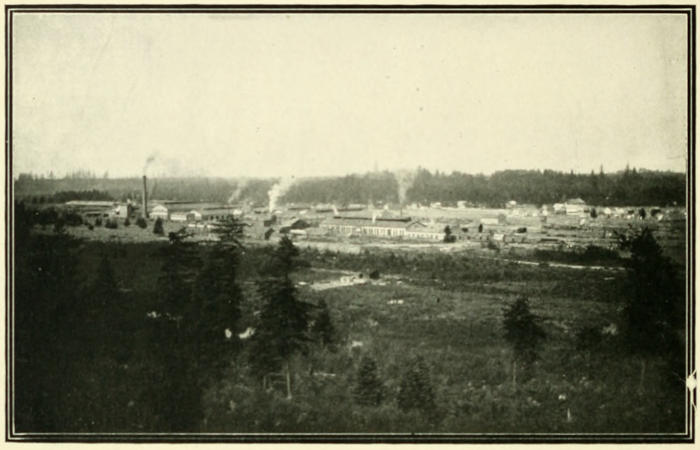
Northern Pacific Railway Construction and Repair Plant.
In this connection the fact should be mentioned that Tacoma is not only the great mart for Washington fir, spruce, hemlock, pine and cedar—soft woods, but has command also of abundant supplies of hard woods, such as maple, oak and ash, which are also found in Western Washington. Among the new Tacoma industries of 1904 is a large plant for the manufacture of parlor furniture from hard woods such as are obtainable in this vicinity or will be brought from the tropical forests of the Philippine Islands by steamships plying between this port and Manila.
The second largest manufacturing plant in Tacoma which is also the largest plant of its description in the Pacific Northwest, is the railway construction and repair plant of the Northern Pacific Railway at South Tacoma. This enormous plant furnishes employment for 800 men and manufactures and repairs everything in the line of motive power or rolling stock for railroad use. A $60,000 building for an additional boiler shop is now being erected to enlarge the facilities for locomotive work. The shops of the Tacoma Eastern railroad and the Tacoma Railway & Power Company are also located at Tacoma. Adjoining the Northern Pacific plant is a large plant of the Griffin Car Wheel Works, and not far distant from South Tacoma is the largest rolling mill in the State, the plant of the Western Iron & Steel Works at Lakeview. Allied to this class of industrial enterprises are numerous foundries and machine shops for the manufacture of stationary and marine engines and boilers, machinery, saws, architectural iron, bridges, and other products of brass, tin, copper, iron and steel. The Puget Sound Dry Dock & Machine Company, of Tacoma, operates the largest private drydock north of San Francisco.
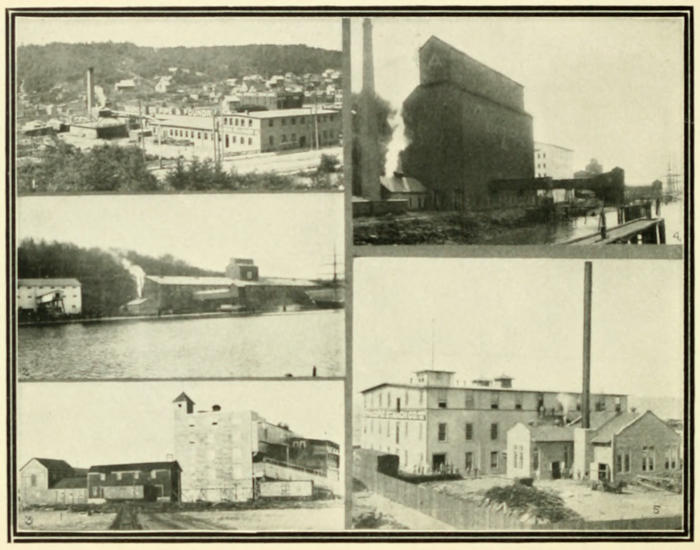
Still another line of industry in which Tacoma takes the lead, is in the reduction of ores of gold, silver, lead, copper and other metals. The Tacoma Smelting Company’s plant on the waterfront at the north end of the city is the largest smelter on the Pacific Coast. In 1902 the plant was enlarged by the addition of huge copper reduction works which began operations in September, 1902, and a copper refinery, the only plant of its kind west of Great Falls, Montana, is now in course of construction. The Tacoma Smelter began operations in September, 1890. In 1891 an average of fifty-eight men were employed, and the value of the output was $781,133.38. Five hundred men are now employed at the smelter and the output of the plant for the year 1903 was as follows:
| Gold, 176,312.41 ounces | $3,644,377.51 |
| Silver, 1,899,831.64 ounces | 1,016,409.93 |
| Lead, 22,488,377 lbs | 955,756.02 |
| Copper, 10,889,463 lbs | 1,422,853.84 |
| Total value of output | $7,039,397.30 |
The amount paid in wages in 1903 was $264,767.60, freight paid to Northern Pacific railway, $336,751.85, and freight paid to vessels, $164,392.55.
Tacoma is the chief flour milling city of the Pacific Northwest. The product of its flour mills in 1903 was valued at $4,075,000. The Puget Sound Flouring Mills Company operate the largest flour mill in the State at Tacoma. The Tacoma Grain Company’s mill adjoining Elevator A was erected in 1902. The Sperry Milling Company, the largest millers in California, in connection with the Tacoma Warehouse & Elevator Company, are erecting a large mill on the waterfront adjoining Elevator B. The Albers Brothers Milling Company are about to erect another large flour and cereal mill on the City Waterway. The plant of the Pacific Starch Company, erected at a cost of $108,000 and opened in August, 1903, for the manufacture of non-chemical wheat starch, is the largest wheat starch factory in the United States. The Coast Cereal Company have erected this year and are now operating a large cereal plant at South Tacoma.
Tacoma has two large breweries. The plant of the Pacific Brewing & Malting Company has been enlarged by the erection of three large cellars, increasing the capacity of the plant to 150,000 barrels a year. Malt is manufactured at Tacoma, not only by local brewers for their own use, but also for the trade. The Puget Sound Malting Company is the only plant on the Coast north of San Francisco engaged exclusively in the manufacture of malt, and supplies the trade in Eastern Washington, Oregon and Alaska, besides the Sound cities. The plant has been doubled in capacity to 240,000 bushels per year since January 1, 1904.
Tacoma has the largest stockyards and slaughtering and meat packing establishment west of the Missouri River Valley. The new plant of the Carstens Packing Company on the tideflats is pronounced to be the best equipped and most complete and up-to-date packing house in the United States. Its capacity is 250 cattle, 500 sheep and 500 hogs per day. It will shortly be in full operation employing 300 men. The plant of the Pacific Cold Storage Company prepares meats for a large trade in Alaska. Tacoma has also large fish canneries, pickling and preserving works, bottling establishments, mineral and soda-water works, coffee and spice mills, flavoring extract and chemical works and candy factories. A large plant is now being erected for the manufacture of crackers and biscuits.
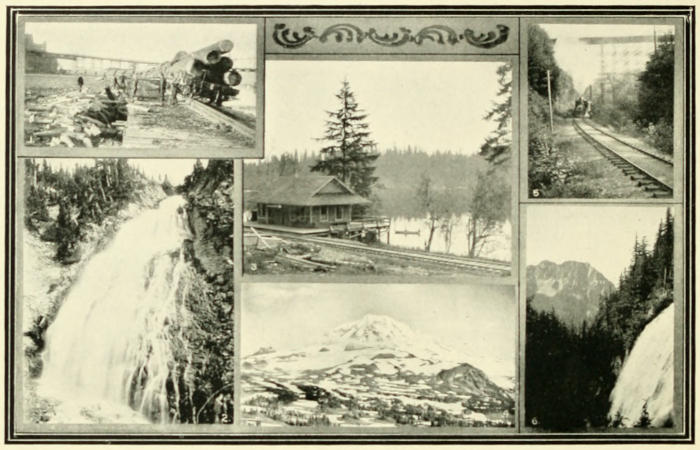
Views Along the Tacoma Eastern Railroad.
Among the other lines of industry in Tacoma not already enumerated are mills or factories for the manufacture of brick and tile; brushes and brooms; artificial ice; soap; tannery products; shoe uppers; boots and shoes; buggy-tops; furs and for goods; clothing; shirts; overalls; stockings; underwear; knit-goods; tents, awnings and sails; paper boxes; fish baskets; oilskin garments and other goods; cigars; cigar boxes; metal bedsteads and woven-wire bed springs; cotton felt; carpets and rugs; excelsior; egg cases; enamels; furnaces and stoves; blank books, ledgers; stencils; rubber stamps; trunks and traveling bags; paints and varnish, and many other articles. TACOMA IS THE LEADING MANUFACTURING CITY OF THE PACIFIC NORTHWEST.
TACOMA HAS THE MOST EXTENSIVE RAILWAY TERMINAL FACILITIES AND HANDLES MORE FREIGHT THAN ANY OTHER CITY IN THE PACIFIC NORTHWEST. The Northern Pacific railway has expended many millions in improvements on the Tacoma waterfront. The official figures furnished by the railroads showing the number of cars of pay freight consigned to each of the three leading cities of the Pacific Northwest during the year 1903 are as follows:
| Cars of freight received at— | |||
|---|---|---|---|
| Railway System. | Tacoma. | Seattle. | Portland. |
| Northern Pacific | 58,779 | 47,219 | 8,463 |
| Tacoma Eastern | 10,074 | ||
| Commercial Dock | 155 | ||
| Great Northern | 9,837 | ||
| Pacific Coast Co. | 11,020 | ||
| O. R. & N | 35,815 | ||
| Southern Pacific | 17,281 | ||
| Astoria & Columbia River | 896 | ||
| O. W. P. & R. Co. | 193 | ||
| Totals | 69,008 | 68,070 | 62,648 |
The Northern Pacific railway operates several distinct lines which radiate from and converge at Tacoma. The Chicago, Burlington & Quincy operates through trains to and from Missouri River points and Tacoma, over the N. P. tracks from Billings, Montana. The Harriman system is to be extended to Tacoma from Portland. The Tacoma Eastern railroad is now in operation from Tacoma to Ashford, with a branch to Electron, 57.5 miles of track being now in operation. This railroad taps the rich timber, coal and agricultural lands on the southerly and westerly slopes of Mount Tacoma. The company owns and is developing extensive coal mines. It is about to extend into the “Big Bottom” country, as the rich and fertile valley of the Upper Cowlitz River is called, from three to twelve miles wide and sixty miles in length, one of the most desirable sections for settlement in the State. The Tacoma Eastern railroad is the gateway to Mount Tacoma and the National Park. The federal government is now constructing a wagon road to Paradise Valley and the Camp of the Clouds, which will connect with the railroad. Paradise Valley and Mount Tacoma are destined to become a great resort for tourists.
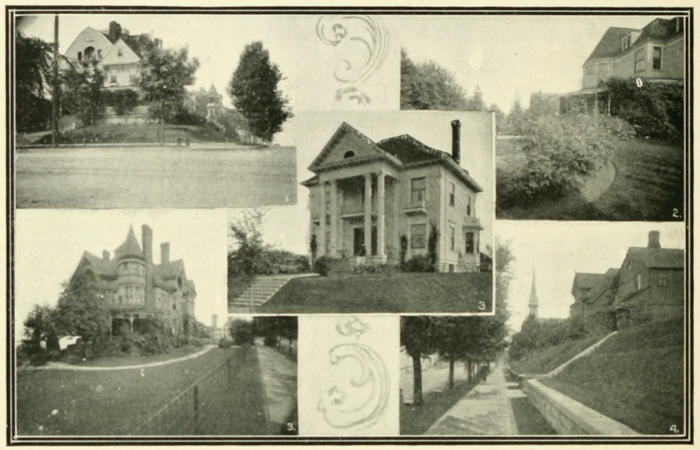
A City of Beautiful Homes.
The general offices of the Puget Sound Electric Railway, operating fifty-three miles of standard gauge electric railway, are at Tacoma. The main line extends from Tacoma to Seattle, with a branch to Renton, twelve miles from Seattle, and an extensive logging road from Edgewood, near Tacoma, through the timber country towards Brown’s Point. This is pronounced to be one of the finest equipped, best constructed and operated electric railways in the country. Thirty-four trains arrive or leave Tacoma daily between six o’clock A. M. and midnight. The road has been in operation about two years and is aiding materially in the settlement and development of the rich Puyallup and White River Valleys between Tacoma and Seattle.
The Tacoma Railway & Power Company operates 85¼ miles of city and suburban electric and cable railways at Tacoma. Lines are operated to Puyallup, 16 miles; to Spanaway, 14 miles, and Steilacoom, 13 miles distant, bringing these towns into close touch with Tacoma, and facilitating the growth of the city’s suburbs. About 400 men are regularly employed as trainmen, trackmen, in the shops and general offices. The increase in the number of passengers carried during the past year is not less than 5,000 per day.
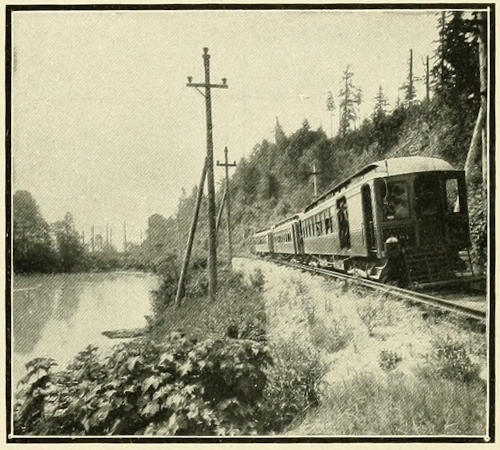
Train on Tacoma-Seattle Interurban Railway.
Tacoma’s ocean commerce exceeds in magnitude and value that of every other port on the Pacific Coast with the exception of San Francisco. President James J. Hill, of the Great Northern Railway, explained the fact with the epigrammatic remark: “Tacoma has the facilities.” Tacoma possesses one of the finest harbors in the world and has the most extensive wharves and warehouses for handling ocean traffic on the Pacific Coast.
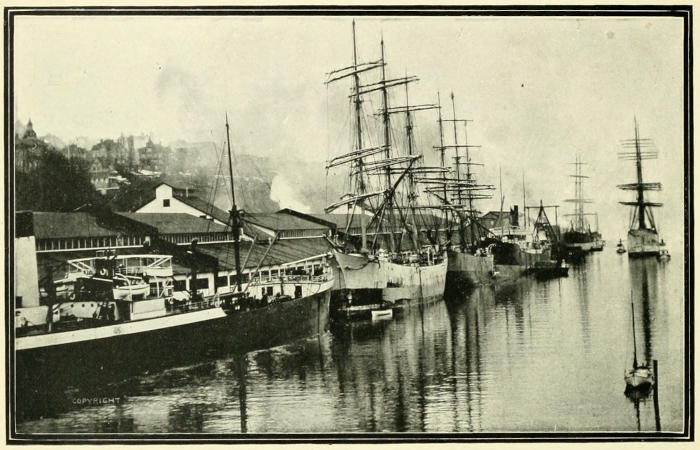
City Waterway from Eleventh Street Bridge.
Tacoma handles the largest share of the foreign trade of the North Pacific Coast, the chief ports of which are Tacoma, Portland and Seattle. The imports and exports of these three ports for ten years from July 1, 1894, to June 30, 1904, inclusive, as shown by the official customs reports, were valued as follows:
| Tacoma | $121,652,289 |
| Portland | 105,590,572 |
| Seattle | 84,911,055 |
Tacoma is the leading port of the Puget Sound customs district, the headquarters of which are at Port Townsend, and which includes Tacoma, Seattle and fourteen other ports. Of the total foreign commerce of the Puget Sound district, Tacoma handles more than 50 per cent., Seattle less than 30 per cent., and the balance is distributed between fourteen other ports in the district. The following are the official figures showing the imports, exports and total foreign commerce of Tacoma, Seattle, and the Puget Sound district for the first six months of 1904:
| Imports. | Exports. | Total Foreign Commerce. |
|
|---|---|---|---|
| Tacoma | $2,835,712 | $5,573,867 | $8,409,579 |
| Seattle | 1,493,455 | 3,071,911 | 4,565,366 |
| Minor ports | 869,176 | 2,633,465 | 3,502,641 |
| Puget S’d Dist. | $5,198,343 | $11,279,243 | $16,477,586 |
In ten years from 1894 to 1903, inclusive, the Puget Sound customs district, of which Tacoma is the chief port, rose from twenty-first to ninth in the magnitude of its foreign commerce among the customs districts of the United States. For the year ending June 30, 1903, Puget Sound was the sixth district in the United States in the tonnage of American and foreign vessels entered and cleared in the foreign trade. The leading customs districts, in the order of their rank in tonnage entered and cleared, are New York, Boston, Philadelphia, New Orleans, Baltimore, Puget Sound, San Francisco, Galveston, Portland (Maine), and Pensacola.
While Puget Sound ranks ninth among the customs districts of the United States in the magnitude of its ocean commerce, measured by the value of its imports and exports, this district stands first in the United States in exports of manufactured lumber, boards, deals and planks; shingles; fowls, and bristles. Second in exports of sheep, buckwheat, oats, baking powder, cotton cloths, dried herring, canned salmon, hay, malt liquors and manufactures of tin. Third in exports of cycles, ginseng, eider, copper ore, printing paper, milk and onions. Fourth in exports of barley, wheat, wheat flour, bran, middlings and mill-feed, candies, canned fruits and gunpowder. Fifth in exports of eggs and malt. Sixth in exports of furniture, salt, hogs, oysters, hops and nursery stock. Seventh in exports of horses and copper, and eighth in exports of fresh fish.
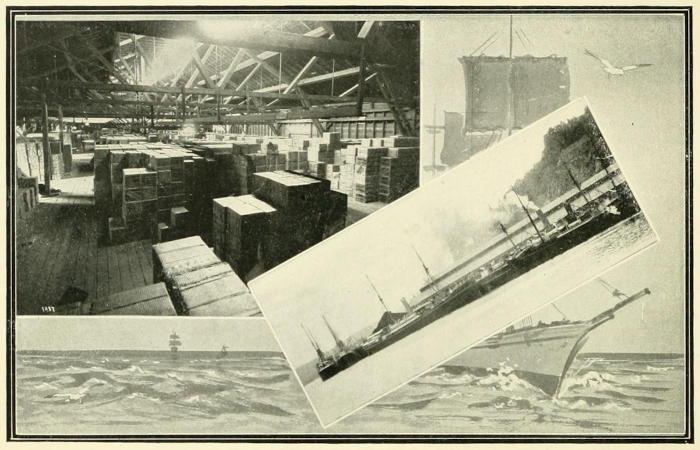
Oriental Wharves and Warehouses.
Tacoma’s ocean commerce may be classified as foreign and coastwise. The latter includes chiefly shipments to and receipts by water from Alaska, Hawaii and California. The foreign trade of Tacoma extends to every continent on the globe and to the islands of the sea. The coastwise receipts are chiefly ores, salmon and furs from Alaska, and fruits, general merchandise and manufactures from California. The coastwise shipments consist chiefly of merchandise sold by Tacoma jobbers to customers in Alaska, provisions, machinery, lumber, feed, etc.; bullion, coal, lumber and flour to California, and coal, lumber and merchandise to Hawaii. The foreign commerce of the port consists of imports of silk, tea, mattings, Manila hemp, and other Oriental products, ores for the Tacoma smelter, grain bags for Washington wheat, cement and fire-bricks for building purposes, iron and steel and other foreign commodities imported into the United States; and exports the most valuable of which are Washington products, wheat, flour, canned and salt salmon, lumber, bottled beer, barley, hay and oats, besides cotton, domestics, bicycles, tobacco and other products and manufactures of Eastern and Southern States. But by far the greater part of Tacoma’s exports are products of the State or of Tacoma mills.
The Oriental trade of the Pacific Coast now centers at Tacoma. In June, 1892, the first steamship for the Orient from Puget Sound was dispatched from Tacoma. In 1903, forty-four regular liners sailed from Tacoma for the Orient, carrying cargoes valued at $8,149,906 from Tacoma, and cargo from Seattle valued at $946,318.
Tacoma is the home port of the Boston Steamship Company, which operates a line of five large steamships of American build and registry between Puget Sound and the Orient. This line was established in July, 1902. During the first two years of its operation, there were thirty-five sailings from Tacoma for the Orient and thirty-two arrivals by vessels of the line. Cargoes of foreign merchandise valued at $6,146,488 were landed at Tacoma, while domestic merchandise for export to the value of $6,444,911 was loaded on vessels of the line at this port. Seattle furnished additional cargo for the line to the value of $2,505,935. Tacoma has handled 83.4 per cent. of the total foreign commerce carried by the Boston Steamship Company since the inauguration of its Puget Sound-Oriental line.
The China Mutual Steamship Company, Ltd., and the Ocean Steamship Company, Ltd., both of which are owned by Alfred Holt & Company, British ship owners, operate a joint service between Tacoma and Liverpool and Glasgow by way of the Orient, Suez Canal and Mediterranean route. Dodwell & Company, the Tacoma agents of the line, shipped from Tacoma in 1903, for the Orient and Europe, by this service and the smaller steamships of the Northern Pacific Steamship Company, cargoes valued at $4,635,325, with additional cargo from Seattle valued at $31,805. The steamships Tacoma, Victoria and Olympia, for many years in the Tacoma-Oriental trade, have recently been sold, the traffic having outgrown their capacity. The cargo capacity of these pioneer steamships in Tacoma’s Oriental trade ranged from 3,000 to 3,800 tons. The new steamships in the service have cargo capacity ranging from 6,739 tons to 18,000 tons. The Shawmut and Tremont of the Boston Steamship Company, and the Ning Chow, the Oanfa and the Keemun of the Holt lines, are the largest carriers in the Trans-Pacific trade.
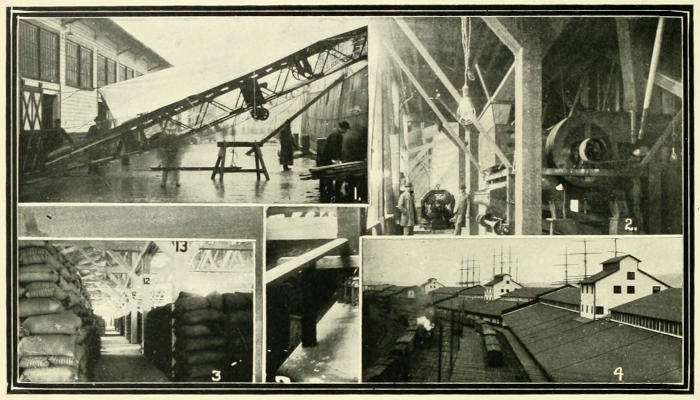
Tacoma’s Wheat Warehouses.
The Kosmos Line operates a regular service between Puget Sound and Hamburg by way of Mexican, Central and South American ports. In 1903 there were fifteen sailings from Puget Sound by steamships of this line, Tacoma furnishing nearly 70 per cent. of the total cargoes carried from the Sound.
The largest vessels engaged in the coastwise trade from Tacoma are the steamships of the American-Hawaiian line operating from Tacoma to Honolulu and New York, returning by way of San Francisco. The Arizonian, Alaskan and Texan of this line, are vessels of 8,671 tons gross register and 12,000 tons cargo capacity. There were fourteen sailings from Tacoma for Honolulu and New York by this line in 1903.
Two lines of steamships are operated regularly between Tacoma and other Sound ports and San Francisco, and several lines to Alaska. A fleet of colliers also plies constantly between Tacoma and San Francisco, carrying coal from this port. In 1902, 375,183 tons of coal were shipped as cargo from this port, exclusive of fuel for steamships. In 1903, the shipments of coal increased to 488,723 tons.
Tacoma handles the largest share of the staple products of the State of Washington, lumber, wheat, flour and coal. The shipments of lumber and coal have already been stated. Tacoma’s facilities for the handling of wheat are unequalled at any other port in the world. The new wheat warehouses erected in 1900 and 1901 on the city waterway, are the longest in the world, being 2,360 feet in length and 148 feet in width. They doubled the warehouse capacity for grain at this port and afford admirable facilities for receiving the wheat from the cars, cleaning and sacking it and loading it on ocean carriers. There are also two enormous grain elevators and three large flour mills on the waterfront. Tacoma’s facilities for exporting wheat and flour are so extensive that in October, 1902, no less than twenty-five wheat carriers were loaded and dispatched and the exports of the month included upwards of 2,000,000 bushels of wheat and 200,000 barrels of flour.
Tacoma is now the leading wheat and flour shipping port on the Pacific Coast, and the customs district of Puget Sound, of which Tacoma is the leading port, now ranks fourth in the United States in both wheat and flour exports, and fourth also in the combined exports of wheat and wheat flour reduced to wheat measure, each barrel of flour being equivalent to four and one-half bushels of wheat.
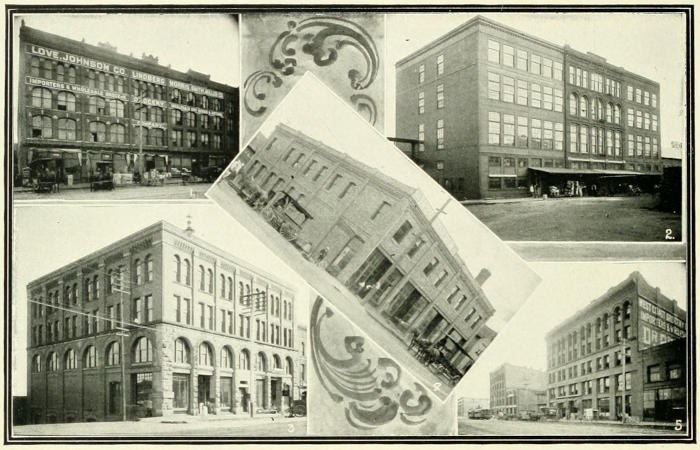
Group of Wholesale Houses.
THE PUGET SOUND CUSTOMS DISTRICT, OF WHICH TACOMA IS THE LEADING PORT, HANDLING 90 PER CENT. OF THE WHEAT AND 60 PER CENT. OF THE FLOUR EXPORTS OF THE DISTRICT, ROSE FROM TENTH TO FOURTH PLACE IN WHEAT EXPORTS AND FROM SEVENTH TO FOURTH PLACE IN FLOUR EXPORTS IN THREE YEARS FROM 1900 TO 1903.
The following table, compiled from the records of the Tacoma harbormaster, shows the total value of Tacoma’s ocean commerce, foreign and coastwise, for the last five years:
| Coastwise and Foreign— | |||
|---|---|---|---|
| Receipts. | Shipments. | Total. | |
| 1899 | $8,607,196 | $12,195,915 | $20,803,111 |
| 1900 | 9,058,325 | 14,858,507 | 23,916,822 |
| 1901 | 11,495,859 | 22,904,877 | 34,400,736 |
| 1902 | 12,544,865 | 27,886,800 | 40,431,665 |
| 1903 | 13,335,398 | 21,861,972 | 35,497,370 |
Tacoma has a large and steadily increasing jobbing trade. Seventeen individual firms and corporations are engaged in the export trade in grain. There are sixty-three concerns engaged in the manufacture or sale of lumber, many of the number being large wholesalers. There are a number of importing houses which handle Oriental goods, fire-brick, cement, grain bags and other foreign products for which there is a local demand.
Wholesale houses are established at Tacoma which supply the trade in groceries and provisions, produce, cereals, flour and feed, meats, fish, wines and liquors, confectionery, tobacco and cigars, dry goods and notions, furs, boots and shoes, drugs, paints and oils, hardware, building materials and contractors’ supplies, belting and hose, machinery and mill supplies, plumbers’ supplies, wool, paper, furniture, and coal. There are numerous commission houses and manufacturers’ agents. The West Coast Grocery Company, of Tacoma, has the largest trade in Alaska of any grocery house in the Northwest. The first and only exclusively wholesale house established on Puget Sound in the trade in dry goods and notions was located and opened at Tacoma in January, 1903, after a careful canvass of the merits of other cities. This was quickly followed by the establishment of a wholesale notion house, also handling dry goods. The largest wholesale furniture house in the Pacific Northwest is at Tacoma. One hundred and forty-four wholesale and jobbing houses handled a trade amounting to $26,839,000 in 1903. Two hundred and eighty-six new business houses were opened in Tacoma during 1903, while only three were closed. These figures were furnished by the mercantile agencies.
Tacoma has three national banks, two state banks and one foreign banking corporation, the London & San Francisco Bank, Ltd. There are also various institutions for savings and building loans. The deposits in the banks of discount and deposit aggregate $8,000,000 and are constantly increasing.
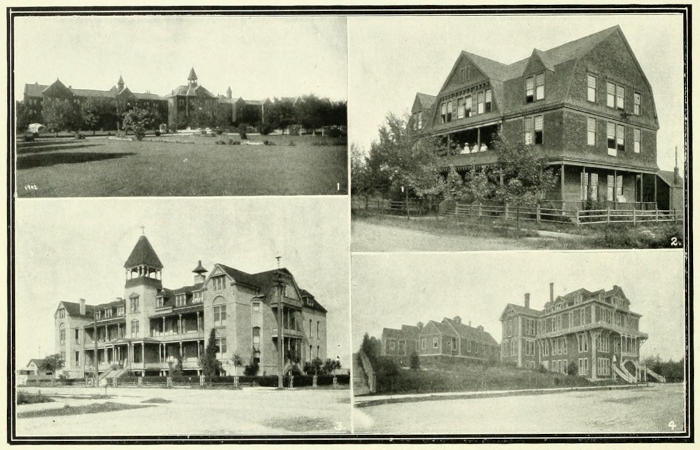
Tacoma’s bank clearings reflect the marvelous growth of business transacted in this city. The total bank clearings for twelve months ending June 30, 1904, amounted to $102,301,642, as compared with $93,348,272 during the previous fiscal year, $51,838,768 during twelve months ending June 30, 1900, and $24,550,442 during twelve months ending June 30, 1897. TACOMA’S BANK CLEARINGS HAVE INCREASED AT THE RATE OF 97.3 PER CENT. IN FOUR YEARS AND AT THE RATE OF 316.7 PER CENT. IN SEVEN YEARS.
The number of real estate conveyances file for record during twelve months ended June 30, 1904, was 6,513, and the amount of expressed consideration was $6,302,837. This is an increase over the previous year of $1,096,206, or at the rate of 21.1 per cent., and in two years of $2,781,428, or at the rate of 79.0 per cent.
There has been a phenomenal increase in building operations at Tacoma amounting to no less than 855.8 per cent. in five years last past. The following is the official record of the building inspector, showing the number and estimated cost of dwellings and total building operations for which permits were issued during the last six years. The building inspector’s record does not cover a large amount of building in the immediate suburbs of Tacoma, for industrial and residence purposes.
| Twelve Mos. ending June |
Dwellings. | Total Permits. | ||
|---|---|---|---|---|
| Number. | Cost. | Number. | Cost. | |
| 1904 | 845 | $883,068 | 1,429 | $1,691,105 |
| 1903 | 620 | 665,895 | 1,043 | 1,543,755 |
| 1902 | 447 | 491,005 | 779 | 869,492 |
| 1901 | 251 | 316,640 | 652 | 692,156 |
| 1900 | 130 | 97,350 | 422 | 417,845 |
| 1899 | 74 | 51,195 | 371 | 176,934 |
Notwithstanding the investment of millions of dollars in Tacoma realty and improvements, the mortgage indebtedness shows no appreciable increase. In 1903, realty transfers reciting a consideration of $4,646,537, were recorded and permits were issued in the city of Tacoma for improvements estimated to cost $1,700,000. The net increase in the mortgage indebtedness, as shown by the record of mortgages and mortgage releases, was $169,655, or only 2.6 per cent. of the amount involved in real estate purchases and improvements.
The federal government has purchased a site for a much needed public building at Tacoma, which will shortly be erected. Tacoma is the headquarters of the new Internal Revenue Collection District of Washington and Alaska. Federal collections at Tacoma for the fiscal year ending June 30, 1903, were as follows: Internal revenue, $688,696.50; customs, $301,039.32; postoffice receipts, $113,598.66; total, $1,103,334.48. Postoffice receipts have increased at the rate of 132.1 per cent. in seven years.
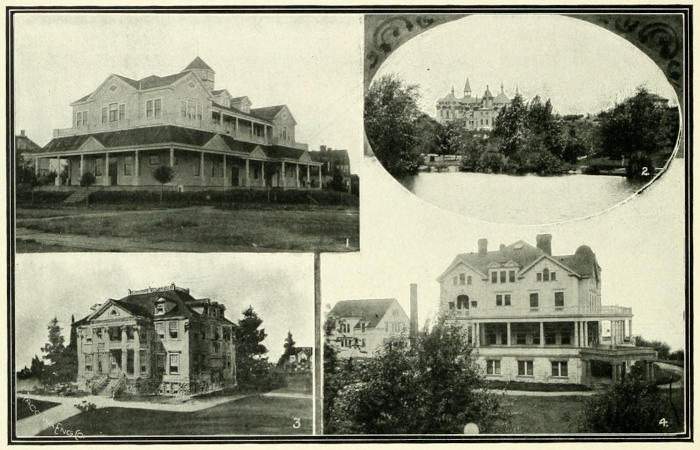
Extensive municipal improvements are in progress. Among the more important are several miles of asphalt and brick paving; fifty miles of new sidewalks, principally of cement; sewers, water mains and bridges. Tacoma owns and operates its own water and electric lighting plants, supplying both water and light to private consumers. The city procures current from the power companies at the lowest rates paid in the United States and receives a large and increasing revenue from operation, notwithstanding recent reductions in rates, which are as low to private consumers as in any American city. Tacoma maintains an efficient free employment bureau.
The assessed valuation of taxable property in Tacoma in 1903 was $22,468,988. The bonded indebtedness, exclusive of the water and light debt, is $1,743,000. The city has no floating indebtedness and has a sinking fund amounting to $135,734.52, largely invested in Tacoma city bonds bought in the market at 110. The city owns property valued at $3,250,000. The light and water debt of $2,080,000 represents the capital invested in a profitable business which produces a revenue to the city.
Tacoma has twenty-one public schools of the primary and grammar school grades and a high school. A magnificent building with accommodations for 1,200 pupils is being erected for the high school. The enrollment in the public schools for the year 1903-04 was 8,939 and the average daily attendance 7,066. The value of school property in the district is $988,040, while the total liabilities, including bond and warrant indebtedness amounted to $492,523.02 on June 30, 1904, with a cash balance on hand of $36,554.82.
Tacoma is the seat of Whitworth College, founded and conducted by the Presbyterian Church, which occupies a conspicuous location overlooking the Sound. The University of Puget Sound is under the auspices of the Methodist Episcopal Church. The University occupies a fine new building at the West End. The Annie Wright Seminary is a boarding and day school for girls. It is liberally endowed and has a valuable property near Wright Park. The Pacific Lutheran Academy and Business College is at Parkland, a suburb at the south. Vachon College is at Burton, on Quartermaster Harbor. The Academy of the Visitation and St. Aquinas Academy are schools for girls under Roman Catholic auspices. There are also two business colleges, a training school for nurses in connection with the Fannie Paddock Hospital, and schools of music and art.
Tacoma has upwards of eighty church organizations, representing all the leading religious denominations. Tacoma is the see city of the Episcopal Jurisdiction of Olympia.
The Ferry Museum occupies the fourth and fifth floors of the County Court House. It has extensive collections of natural history, art, sculpture, Indian baskets and[48] relics, Oriental curios and the like. The Tozier exhibit is the most extensive Indian collection in the world.
Tacoma has a new public library building completed and opened in 1903, the gift to the city of Andrew Carnegie, who gave $75,000 for the building, the city providing the site. The library contains 30,000 volumes.
There are two large and well-equipped general hospitals at Tacoma, St. Joseph’s Hospital, and the Fannie C. Paddock Memorial Hospital, also a large new Pierce County Hospital. A $100,000 hospital for the employes of the Northern Pacific railway is now building. At Steilacoom is the Western Washington State Hospital for the Insane. There are three children’s homes for orphans or friendless children, and numerous benevolent and charitable institutions.
Tacoma has 800 acres of beautiful parks. Point Defiance Park occupies the northerly extremity of the peninsula on which Tacoma is built. It has about three miles of shore line on the Sound and most of it is covered with giant fir. It is a park of unusual natural beauties and attractions. Wright Park is a garden, twenty-eight acres in extent in the heart of the city, with a great variety of shrubs, trees and flowers.
Tacoma, the industrial and commercial center of the Empire State of the Coast, is an inviting field for enterprise and effort and offers boundless opportunities for the profitable employment of capital in manufactures, trade, commerce and transportation, and rich rewards for the exercise of brains and well-directed energies.
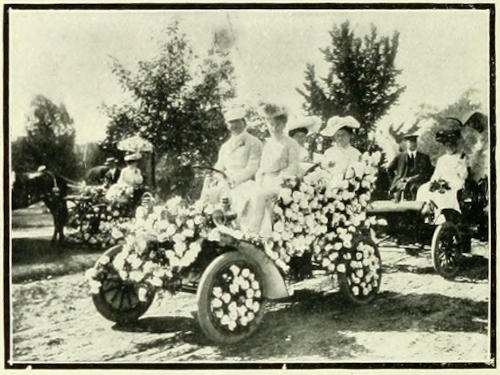
Decorated for Tacoma’s Rose Carnival.
| Months. | 1901-02. | 1902-03. | 1903-04. | |||||||||
|---|---|---|---|---|---|---|---|---|---|---|---|---|
| Dwellings. | Total Permits. | Dwellings. | Total Permits. | Dwellings. | Total Permits. | |||||||
| No. | Cost. | No. | Cost. | No. | Cost. | No. | Cost. | No. | Cost. | No. | Cost. | |
| July | 29 | $ 35,040 | 66 | $ 66,845 | 38 | $ 43,955 | 73 | $ 76,945 | 79 | $ 74,640 | 113 | $ 125,680 |
| August | 23 | 29,990 | 47 | 59,540 | 42 | 42,850 | 70 | 150,880 | 90 | 96,135 | 149 | 120,401 |
| September | 38 | 52,200 | 63 | 137,741 | 39 | 48,660 | 69 | 113,555 | 84 | 88,150 | 144 | 170,345 |
| October | 30 | 21,125 | 61 | 36,941 | 45 | 43,252 | 81 | 120,700 | 68 | 65,720 | 117 | 148,783 |
| November | 22 | 21,290 | 34 | 24,520 | 42 | 39,140 | 77 | 54,095 | 45 | 33,730 | 78 | 122,225 |
| December | 17 | 15,800 | 25 | 31,200 | 20 | 22,075 | 43 | 70,695 | 44 | 35,900 | 84 | 56,015 |
| January | 33 | 34,900 | 55 | 53,340 | 49 | 51,130 | 77 | 84,785 | 55 | 57,360 | 92 | 116,553 |
| February | 37 | 46,650 | 60 | 68,900 | 60 | 75,410 | 100 | 116,725 | 62 | 64,485 | 105 | 121,675 |
| March | 55 | 57,075 | 84 | 109,050 | 71 | 72,505 | 106 | 306,012 | 68 | 72,100 | 115 | 92,950 |
| April | 55 | 57,415 | 96 | 104,320 | 78 | 76,660 | 131 | 190,990 | 83 | 100,580 | 128 | 135,600 |
| May | 72 | 73,460 | 122 | 100,280 | 62 | 67,595 | 99 | 111,743 | 86 | 97,160 | 160 | 234,582 |
| June | 36 | 46,060 | 66 | 76,815 | 74 | 82,463 | 117 | 146,630 | 81 | 97,108 | 144 | 246,296 |
| Totals | 447 | $491,005 | 779 | $869,492 | 620 | $665,695 | 1043 | $1,543,755 | 845 | $883,068 | 1429 | $1,691,105 |
| Months. | 1901-02. | 1902-03. | 1903-04. |
|---|---|---|---|
| July | $ 4,318,153.03 | $ 5,409,206.75 | $ 7,715,579.70 |
| August | 4,594,683.55 | 5,945,993.04 | 7,308,197.37 |
| September | 5,252,834,60 | 6,244,709.50 | 8,330,087.33 |
| October | 5,982,652.46 | 8,569,541.60 | 9,268,786.11 |
| November | 5,537,297.55 | 8,460,959.94 | 8,764,691.01 |
| December | 5,031,807.23 | 9,681,493.06 | 10,060,853.96 |
| January | 5,414,839.63 | 8,969,399.35 | 8,719,901.12 |
| February | 4,267,933.49 | 7,521,557.21 | 8,175,534.17 |
| March | 5,243,385.69 | 8,639,380.86 | 9,144,338.91 |
| April | 5,266,410.53 | 8,162,920.94 | 8,231,909.76 |
| May | 5,508,605.51 | 7,965,403.09 | 8,299,838.70 |
| June | 5,736,684.64 | 7,767,707.08 | 8,281,923.53 |
| Totals | $62,155,287.91 | $93,348,272.42 | $102,301,641.67 |
| Months. | 1901-02. | 1902-03. | 1903-04. |
|---|---|---|---|
| July | $ 6,828.06 | $ 7,854.42 | $ 8,934.53 |
| August | 6,036.91 | 6,603.76 | 8,708.47 |
| September | 7,098.88 | 7,620.88 | 8,736.62 |
| October | 7,163.26 | 8,209.68 | 10,277.23 |
| November | 7,439.21 | 7,867.43 | 9,264.48 |
| December | 8,498.15 | 10,269.96 | 11,837.96 |
| January | 8,473.29 | 9,277.34 | 10,053.33 |
| February | 7,330.70 | 9,024.62 | 9,613.01 |
| March | 7,238.57 | 8,360.07 | 9,807.18 |
| April | 7,592.38 | 8,357.45 | 9,021.51 |
| May | 8,069.68 | 7,651.96 | 8,551.12 |
| June | 6,998.30 | 8,128.26 | 8,793.22 |
| Totals | $88,767.39 | $99,225.83 | $113,598.66 |
(Compiled from latest obtainable statistics. “1903-4” refers to the fiscal year ending June 30, 1904.)
Population of Tacoma and environs, July 1, 1904; 67,405. Increase in four years—25,094, or at the rate of 59.3 per cent.
Post Office Receipts, 1903-4, $113,598.66. Increase—14.7 per cent. in one year; 28.2 per cent. in two years; 53.7 per cent. in three years; 77.4 per cent. in four years; 132.1 per cent. in seven years.
Bank Clearings, 1903-4, $102,301,272.42. Increase—9.6 per cent. in one year; 64.6 per cent. in two years; 77.0 per cent. in three years; 97.3 per cent. in four years; 316.7 per cent. in seven years.
Building Permits, 1903-4, 1,429. Increase—37.0 per cent., in one year; 80.8 per cent. in two years; 134.5 per cent. in three years; 238.6 per cent. in four years.
Cost of Building Improvements, 1903-4, $1,691,105. Increase—9.5 per cent. in one year; 94.5 per cent. in two years; 144.3 per cent. in three years; 304.7 per cent. in four years; 855.8 per cent. in five years.
Realty Transfers, 1903-4, $6,302,837. Increase—21.1 per cent. in one year; 79.0 per cent., in two years.
Customs Receipts, 1903-4, $301,039.32. Increase—148.3 per cent. in four years; 356.7 per cent. in six years.
Ocean Commerce, 1903-4, $37,362,782. Increase—2.2 per cent. in one year; 28.0 per cent. in three years; 63.8 per cent. in four years.
Cut of Lumber Mills, 1903, 361,522,766 feet. Increase—19.0 per cent. in one year; 65.0 per cent. in two years; 96.6 per cent. in three years.
Product of Shingle Mills, 1903, 376,935,500 shingles. Increase—94.0 per cent. in three years.
Output of Tacoma Smelter, 1903, $7,059,397.30. Increase—188.7 per cent. in three years.
Daily Capacity of Flouring Mills, 1904, 5,550 barrels. Increase—146.7 per cent. in four years.
Number of Telephones in use, July 1, 1904, 6,192. Increase—250.4 per cent. since Jan. 1, 1900.
Miles of Electric Railway—Urban, Suburban and Interurban—in operation, 1904, 138¼. Increase—100 per cent. in three years.